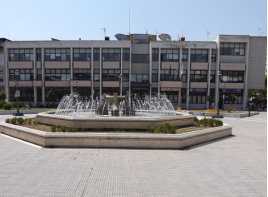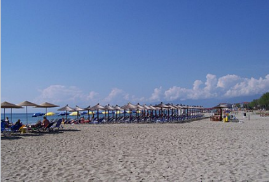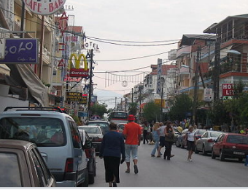Katerini, Pieria, Central Macedonia 作者: 来源: 发布时间:2021-05-17
I. Population, Area and Transportation
Total Area: 681.863 km2
Elevation: 14 m (46 ft)
Municipal unit density: 660/km2 (1,700/sq mi)
Population: 58,309(2011)

II.Natural Geography (environment and resources)
Local Transport
The Urban KTEL of Katerini serves the connection between Katerini and its nearby settlements. The bus hub is in Katerini and it has lines towards Moschochori, Paralia, Dion, Pieria, Aronas and Nea Trapezounta. These lines serve all the settlements that lie between Katerini and the aforementioned final destinations.
Road Transport
Katerini is served by A1 and National Road 1 that run north-south from Evzonoi to Athens. The connection between Katerini and Elassona is served by National Road 13. Single carriageways run from Katerini to every settlement of the Pieria. Bus lines, delivered by the Intercity KTEL of Pieria, connect Katerini directly with Athens, Thessaloniki, Elassona, Alexandreia and all the settlements of Pieria that are not served by the Urban KTEL of Katerini. There are also privately held international bus lines that connect Katerini with several cities in Albania and Bulgaria.
Rail Links
Katerini railway station is located just outside the city centre. The main line of the Greek railway system that connects Athens with Thessaloniki passes through Katerini. As a result, the city is connected directly with Larisa and Thessaloniki via the Proastiakos. It is also connected with Athens and all the intermediate stations by Intercity train lines.

III. ECONOMY
Katerini is the administrative and economic centre of Pieria. The Chamber of commerce and industry of Pieria is based in Katerini. The same applies for the Union of Agricultural Cooperatives of Pieria and the Union of hotel owners of Pieria.
Katerini lies in the middle of a plain and thus, it is greatly an agricultural city. As of 2000 26,775 people were occupied in agriculture, in Pieria. The Union of Agricultural Cooperatives of Pieria has 9,000 members, of which 2,000 grow tobacco. Kiwifruit is also produced in Katerini.
Katerini is a popular tourist destination, that attracts tourist both from Greece and abroad. Within the boundaries of the municipality, there are over 230 hotels that can accommodate more that 8,600 people. The vast majority of the tourist infrastructure lie in Paralia and Olympiaki Akti and it also includes tens of tavernas and cafes. Winter tourism has started developing in the area, since the construction of the Elatochori ski resort. Katerini is surrounded by ancient archaeological sites as Dion, Leivithra, Pydna, Louloudies and Platamon Castle which are worth a visit.

IV. Industrial Characterisitics
Katerini is the administrative and economic centre of Pieria. The Chamber of commerce and industry of Pieria is based in Katerini. The same applies for the Union of Agricultural Cooperatives of Pieria and the Union of hotel owners of Pieria.
V. History
The origin of the name is obscure. Since the 13th century, travellers as well as maps record the existence of a settlement called Hatera, which may have been the origin of the modern name. Thus Felix Beaujour recorded its name as "Katheri", while François Pouqueville gives the name of the settlement as "Kateri Hatera".
According to another theory, the city derives its name from the small chapel dedicated to Saint Catherine (Aikaterini in Greek) to the east of the city, dating to at least the early 19th century. The latter hypothesis influenced official usage in Greek, where the city is found as "Aikaterini" or "Agia Aikaterini" until the early 20th century, when the vernacular name Katerini prevailed.
According to the reports of travellers, at the turn of the 19th century, the city had four to five thousand inhabitants, mostly Greeks. In 1806, William Martin Leake recorded 100 hearths, while four years later Daniel recorded 140. For the remainder of the 19th century, the number of homes remained steady at about 300, with a population in 1900 of 2,070 Greek Orthodox mostly Vlach, and 600 Muslims, most of them of Albanian origin.
The city was captured by the Greek 7th Infantry Division on 16 October 1912, during the First Balkan War, and has been part of Greece since then. With the population exchange between Greece and Turkey in 1923, the city's Muslims left, and Greek refugees, particularly from Eastern Thrace and Greek Evangelicals from Asia Minor, took their place, almost doubling the city's population from 5,540 in 1920 to 10,138 in 1928.
VI. Contact Information
Mayor: Konstantinos Koukodimos
Official Website: www.katerini.gr
Mailbox: mayor@katerini.gr
Phone: 2351350410
